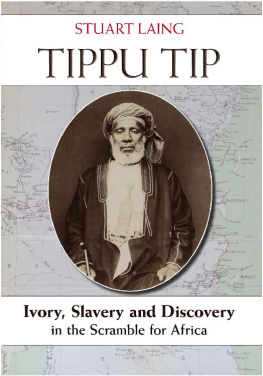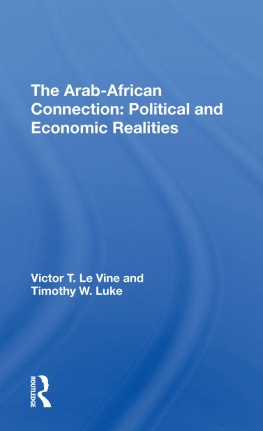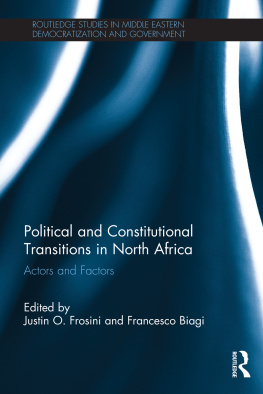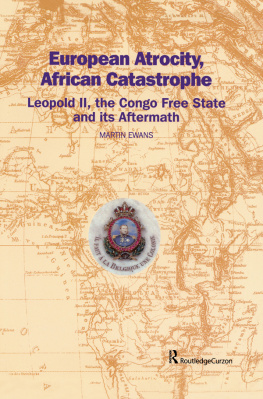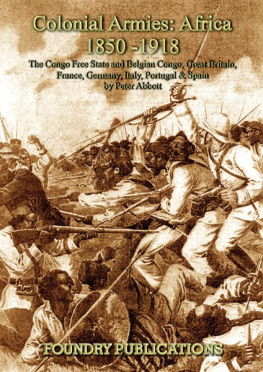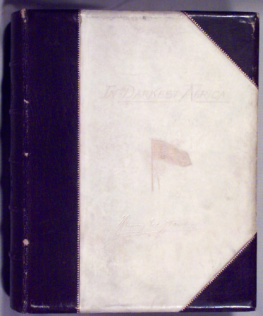TIPPU TIP

Hamed bin Mohammed al-Murjabi, also known as Tippu Tip, sits for his formal studio portrait in Zanzibar, ca . 1890s.
He was described by the Briton Herbert Ward as a very remarkable individual in every way of commanding presence, and a wonderful degree of natural ease and grace of manner and action. He stands nearly six feet in height, has brilliant, dark, intelligent eyes, and bears himself with an air of ultra-imperial dignity.
(Ward 1890: 491)
TIPPU TIP
Ivory, Slavery and Discovery in the Scramble for Africa
Stuart Laing

Tippu Tip
Ivory, Slavery and Discovery in the Scramble for Africa
Stuart Laing 2017
ISBN: 978-1-911487-05-0
Produced and published in 2017
by
Medina Publishing Ltd
310 Ewell Road
Surbiton
Surrey KT6 7AL
medinapublishing.com
Edited by William Facey
Designed by Kitty Carruthers
Maps by Martin Lubikowski
The moral right of the author has been asserted according to the Copyright, Designs and Patents Act 1988
All rights are reserved. No part of this publication may be reproduced, stored or introduced into a retrieval system, or transmitted, in any form, or by any means (electronic, mechanical, photocopying, recording or otherwise) without prior permission in writing of the publisher and copyright holder.
A catalogue record for this book is available from the British Library
Printed and bound by Interak Printing House, Poland
Contents
List of maps
List of illustrations
Between pages 178 and 179
Tippu Tip. Portrait photograph taken by GPA, published in Hoffmann 1938
Sayyid Said bin Sultan. Painting; by courtesy of Bait al-Zubair Museum, Muscat
John Hanning Speke. Full-length portrait painted by James Watney Wilson; by courtesy of the Royal Geographical Society, London
Richard Burton. Photograph, from the portrait by Lord Leighton in the National Portrait Gallery, London; by courtesy of the Royal Geographical Society, London
Verney Lovett Cameron. Portrait photograph; by kind permission of the Syndics of Cambridge University Library
Livingstone in swamp near Lake Bangweolo. Engraving from Waller 1874
Ivory caravan. Photograph from the Fisher Collection; by kind permission of the Syndics of Cambridge University Library
Ivory objects. From the authors family collection
Henry Morton Stanley in Makata swamp. Engraving from Stanley 1872
Ujiji, Lake Tanganyika. Engraved view from Hore 1892
Henry Morton Stanley. London studio portrait; by courtesy of the Royal Geographical Society, London
Tusks in doorway of merchants house, Zanzibar. Photograph from the J.A. Grant Collection; by kind permission of the Syndics of Cambridge University Library
The front door of Tippu Tips house, Zanzibar. Photograph by the author
The plaque beside Tippu Tips front door, Zanzibar. Photograph by the author
Detail of wood carving, Tippu Tips front door, Zanzibar. Photograph by the author
Ivory warehouse, Zanzibar. Photograph from the Christie Collection; by kind permission of the Syndics of Cambridge University Library
Sayyid Barghash with his delegation visiting England, 1875. Photograph; by courtesy of Zanzibar Archives
John Kirk. Photograph reproduced from Foskett 1946
Dr James Christie. Photograph in a book of his letters; by kind permission of the Syndics of Cambridge University Library
Princess Salme bint Said. Photograph; by courtesy of Zanzibar Archives
King Leopold II of the Belgians. Portrait engraving; from Stanley 1885
Hermann von Wissmann. Sketch portrait; from Brown 189295
Jrme Becker. Portrait engraving; from Becker 1887
Tippu Tips majlis , probably in Nyangwe. Engraving; from Ward 1890
Walter Deane escaping from Stanley Falls. Illustration; from Ward 1890
The steamboat Le Stanley . Engraving; from Ward 1890
Rooftop view of Zanzibar, early 20th century. Photograph, from the Royal Commonwealth Society Collection; by kind permission of the Syndics of Cambridge University Library
Zanzibar waterfront, early 20th century. Photograph, from the Royal Commonwealth Society Collection; by kind permission of the Syndics of Cambridge University Library
View from the roof of Bait al-Ajaib, 2012. Photograph by the author
Foreword and Acknowledgements
T HE AIM OF THIS BOOK is to introduce the reader, through the life of Tippu Tip, to the extraordinary world of East Africa in the second half of the 19th century the time of the Scramble for Africa when European powers took over huge areas of the continent in a largely unplanned campaign of colonial and imperial expansion. Tippu Tip both spearheaded the Arab effort to open up Central Africa from the east, and watched from a ringside seat as Arab influence in the region was whittled away. In the latter process he played a significant role by co-operating with Western explorers, most notably with Henry Morton Stanley. His ability to face both ways found its most piquant expression when King Leopold II of Belgium engaged him as a governor in the eastern Congo. By following Tippu Tips life, we can begin to understand how and why these momentous events unfolded processes which have left strong traces in Africa still today.
I first came across Tippu Tip when researching for a dissertation on the abolition of slavery and the slave trade in East Africa and the Indian Ocean in the 19th century. He immediately seemed an intriguing character. Dismissed in some accounts as a notorious slave trader, there was obviously more to him than that. For one thing, the evidence suggests that he was primarily interested in ivory, not slaves. Not that this makes him an angel, since the quest for ivory had disastrous effects on elephant herds even in (and before) Tippu Tips time, long before the terrible depredations we are seeing today. But he stands out from his Arab contemporaries. Partly this is because he engaged more closely with the world outside Africa. Mainly, however, it is because he left memoirs (the Maisha , which cannot quite be called an autobiography), through which the voice of a 19th-century Arab is clearly heard.
The book also fills a gap in the English-language bibliography of Africa of the Scramble. In Franois Renault, Tippu Tip has had his biographer in French, but in a form not easily accessible to the general reader. I hope that, through this book, more will come to enjoy a knowledge of this interesting episode in African (and European) history, with its cast of remarkable characters.
Acknowledgements
No author works alone. I have been helped by my wife, Sibella, and family members, all supportive of my apparent obsession with Tippu Tip. I am grateful to a number of Africanists who pointed me in the right direction in my research, and particularly to Felicitas Becker in Cambridge, who helped sort out discrepancies in the translations of Tippu Tips memoirs. Clara Semple helped me with illustrations, and on information about the Maria Theresa dollar. Staff in the Cambridge University Library, especially in the Munby Rare Books Room, were invariably helpful in digging out source material. My editor, Will Facey, ironed out many wrinkles, and helped make the book more accessible. I thank them all.
Transliteration and presentation
References to Tippu Tips memoirs (see the ) are given in the form Maisha [paragraph number], using the paragraph numbers in the Smith/Whiteley edition.
Next page
